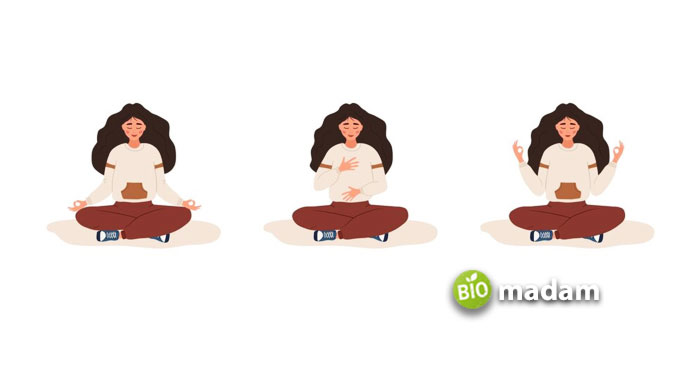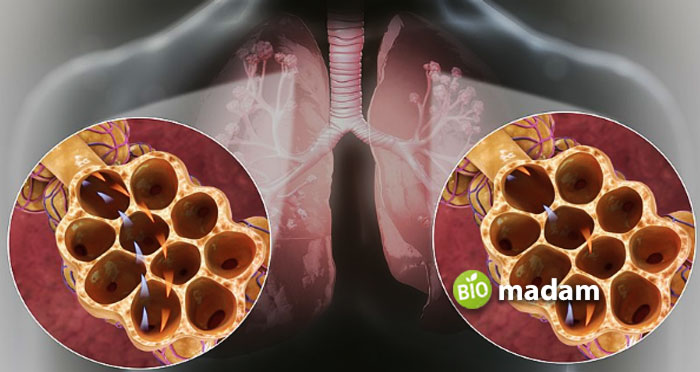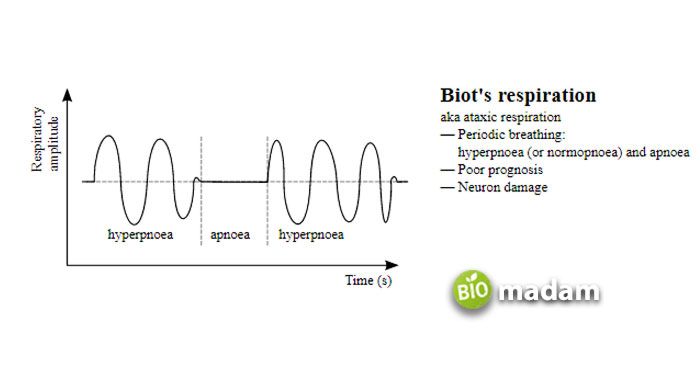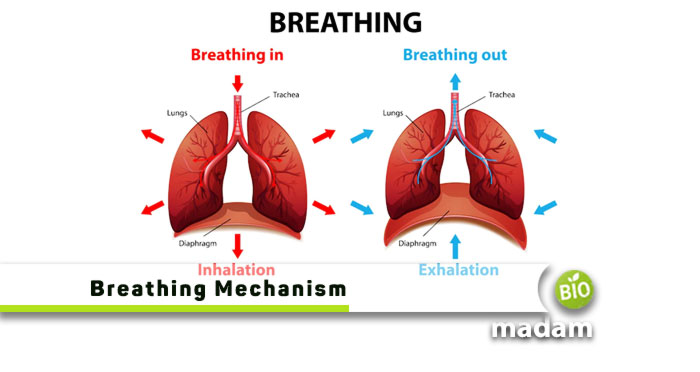Breathing is one of the essential functions in the body that helps you survive. The inhalation and exhalation of air through the respiratory system are critical to living. You may experience some breathing problems, leading to different breathing patterns in specific situations. For example, your breathing pattern after exercise is not the same as when walking. The breathing patterns may also differ in case of respiratory disease or disorder.
In this article, we have compiled all the different types of breathing patterns, including breathing disorder patterns.
Let’s tell you everything about breathing patterns.
What is Breathing?
Breathing is the exchange of air between living organisms and the environment. The process of breathing involves taking in oxygen from the surroundings and giving out carbon dioxide. Unlike respiration in humans, plants use carbon dioxide to produce oxygen during photosynthesis.
The respiration or breathing rate is an important factor in diagnosing a disease. It is determined by observing the inhalation and exhalation cycles of a person. Inhalation refers to taking in oxygen-rich air, and exhalation is the process of expelling carbon dioxide-rich air.
In animals, respiration or breathing occurs through the respiratory system comprising various tissues and organs. This process is crucial to life, and problems in breathing due to anatomical or physiological changes may prove fatal.
Mechanism of Breathing
The breathing mechanism comprises inspiration and expiration due to changes in lung pressure. A fall in air pressure causes the alveolar spaces to allow the air to enter the right and left lung through inspiration. Alternatively, an alveolar pressure higher than atmospheric pressure causes the lungs to expel the air during expiration.
Factors Affecting Breathing
While breathing is an everyday, normal mechanism, various factors affect your pattern and rate of breathing. The factors influencing breathing pattern include:
Physical Activity
The most common reason for elevated breathing is an increase in activity. You may experience it frequently if you work out regularly. Tachypnea is often associated with breathing after a workout session. Click on this link to know about some of the best breathing exercises that will help you stay active.
Location
The variations in biomes and ecosystems also contribute to an increase or decrease in breathing rate due to altitude change. Higher altitudes cause a decrease in oxygen, leading to altering deep and rapid breathing periods with central apnea.
Pathological Conditions
Furthermore, changes in normal body functioning, in case of diseases or pathological conditions, may also influence breathing. People with asthma and COPD are susceptible to altered breathing patterns. Patients with asthma experience a higher breathing rate while COPD patients may have nocturnal hypoventilation.
Types of Breathing Patterns in Humans
All living organisms have different breathing mechanisms using their specific organs. Reptiles breathe through lungs, whereas, amphibians utilize both lungs and skin for respiration. Similarly, mammals, such as humans, also have lungs as the main organ for breathing. They make inspiration and expiration possible by providing an expansion to let in the air. The lungs expand to let the oxygen diffuse across the lung’s surface during inhalation and enter the bloodstream. Similarly, the lungs expel the air out when the pressure rises.
The different types of breathing patterns in humans include:
Eupnea
Eupnea translates to “good breathing.” It is the normal breathing pattern in animals and humans that does not require conscious thinking. For example, you are breathing if you are sitting and watching TV. However, you do not have to think before you breathe. It is a natural process that keeps going on without any audible sound generally.
The breathing pattern may change during exercising despite it not being a dangerous situation. Your body experiences eupnea in resting conditions. This kind of breathing utilizes external intercostal muscles and the diaphragm.
Costal Breathing
Costal breathing refers to shallow breathing and involves the contraction of intercostal muscles. It utilizes rib movements to facilitate inhalation and exhalation while breathing.
The main muscles involved in costal breathing are the intercostals, but it may also include spinal erectors, superior serratus posterior, and levator costarum.
Shallow breathing helps improve flexibility and stabilizes the ribcage, providing a foundation for the shoulders. They might also help enhance neck posture and maintain it.
Diaphragmatic Breathing
As the name suggests, diaphragmatic breathing involves the contraction of the diaphragm. It is also known as deep breathing and involves your abdominal muscles.
The diaphragm is a muscle at the base of the lung involved in breathing. Inhalation or inspiration forces the diaphragm to contract and move downwards. It creates space for the lungs to expand and fill with air. Eventually, the person exhales, causing the diaphragm to relax and move to its original place. It also supports exhalation or expiration.
Diaphragmatic breathing has been seen to help the lungs fill more efficiently and provide more oxygen to the blood. Diaphragmatic breathing is a common exercise to improve breathing. It fully engages the stomach muscles and diaphragm for deeper breaths. You may notice your stomach rising when you inhale.

Types of Breathing Patterns in Other Organisms
Amphibians
Besides animals and plants, other eukaryotic organisms exhibit different breathing patterns. Young amphibians and fishes use gills for breathing in water. Some amphibians also use gills throughout their life. While adult tadpoles have lungs, they are not the same as mammals. They have a reduced diaphragm resulting in forced breathing.
Birds
The respiratory system in birds is modified because of their excessive need for oxygen while breathing. Birds have lungs and air sacs inside the body, contributing to respiratory function. Air enters the posterior air sacs and is expelled from the anterior air sacs in the opposite direction of blood flow. This kind of airflow allows birds to breathe at higher altitudes. However, it takes two respiration cycles to expel the air out of the lungs completely.
Abnormal Breathing Patterns
Besides normal breathing patterns, living organisms, especially humans, may experience abnormal breathing that leads to respiratory diseases. These abnormal patterns may also act as signs and symptoms for various other underlying reasons. Here are the different types of breathing patterns besides normal respiratory function.
Hyperpnea
Hyperpnea describes a breathing pattern with a deep inspiration depth. You may not apparently feel faster breaths, but hyperpnea relates to a higher air intake.
It can be defined as “a higher tidal volume than predicted normal volume.” It means that the person is breathing in and expelling a larger air volume than normal.
It is often known as forced breathing as it makes use of muscle contractions. The forced inspiration involves the neck muscles that contract and lift the thoracic wall. Alternatively, expiration involves the oblique and other muscles in the abdomen. The abdominal organs move upwards towards the diaphragm expelling the air out.
Hyperpnea may result from situations like exercise, diabetic ketoacidosis, more carbon dioxide intake, emotional stress, or heart failure.
Hypopnea
Hypopnea is a term used to describe a condition opposite to hyperpnea. People with hypopnea have a shallow breathing pattern with a lower depth. Thus, the patients have a lower tidal volume than the predicted normal.
It arises from certain medications and pathologies. Some causes of hypopnea include opioids, sedatives, airway obstruction, sleep apnea, and neuromuscular disorders.
Hyperventilation
Hyperventilation is a medical term for fast breathing leading to more loss of carbon dioxide than required. Eventually, it disturbs your blood and plasma balance, making you feel weak and dizzy.
The common causes of hyperventilation include exercise, asthma, or anxiety. You can improve hyperventilation by deep breaths or breathing with one nostril at a time. The old trick of breathing into a paper bag may also help.

Tachypnea
Tachypnea comes from the Greek word Tachy meaning fast, whereas apnea represents breathing. Thus, tachypnea translates to a higher breathing rate than usual.
A person is considered to have tachypnea if their respiratory rate or breathing rate is above 20 breaths per minute. It could be due to pain, exercise, anxiety, hypoxemia, fever, or metabolic acidosis. It is pretty common in Chronic Obstructive Pulmonary Disease, such as chronic bronchitis and emphysema.
Bradypnea
Opposed to tachypnea, bradypnea translates to slow breathing. Bradypnea typically indicates a low supply of oxygen to your body organs than required.
The normal breathing rate to maintain the minute ventilation for proper acid-base balance is 10 to 20 breaths per minute. Thus, in medical terms, anything less than ten breaths per minute is bradypnea.
Patients with bradypnea need comparatively quicker medical care as the body is deprived of enough oxygen. Bradypnea may arise from a lower body temperature, sleep apnea, head injury, carbon monoxide poisoning, or trauma.
Apneustic Breathing
Apneustic breathing refers to a breathing pattern with an increased inhalation time. It involves a gasping inspiration with a pause before the lungs release the air.
The brain plays a major role in breathing, and brain injuries may lead to apneustic breathing. It is not a common occurrence in humans; however, overstimulation of the apneustic center present in the pons of the brain sometimes causes apneustic breathing. The same effect on the pneumotaxic center impacts the control of inhalation duration. Alternatively, weak signals from the pneumotaxic center in the brain elevate inhalation time.
Kussmaul Breathing
Ketoacidosis, especially diabetic ketoacidosis, causes multiple breathing issues, where Kussmaul breathing is the most prevalent. It is considered a combination of tachypnea and hyperpnea in which the tidal volume is higher than normal.
This breathing pattern is common in patients with diabetic ketoacidosis due to a higher level of blood sugar. Eventually, the amount of carbon dioxide in the blood rises. The changes in the amount of gasses in the arteries and veins will lead to a need for faster breathing to utilize blood. It happens as a result of fatigued respiratory muscles. A fruity-smelling breath often indicates Kussmaul in diabetic patients.
Dyspnea
Dyspnea refers to shortness of breath when your body does not receive enough air. There could be various reasons for dyspnea or “shortness of breath.”
- Lung problems
- Heart issues (including heart attack)
- Asthma attack
- High altitude
- Obesity
- Poor overall physical health
Dyspnea may include different conditions exhibited in various ways. Some result in specific conditions like standing up, lying down, or lying on a specific side. Here are the different types of dyspnea explained:
Platypnea: It is a rare dyspnea that causes shortness of breath when you are standing up. Lying down may make you feel better.
Orthopnea: Orthopnea is a condition that causes dyspnea when you lie down, and standing up or sitting may resolve the breathing issue. It is common in people with heart failure and lung issues.
Trepopnea: Trepopnea results from lying on a particular side. It may be either left or right for different people.
Paroxysmal Nocturnal Dyspnea: This dyspnea disturbs you during the night and makes you wake up in the middle of your sleep. It could be a symptom of heart failure.
Cheyne-Stokes
Cheyne-stokes is multiple-pattern breathing that may occur due to brain injury, kidney failure, or ketoacidosis. This pattern comprises three phases: shallow breathing and deep fast respiration. Eventually, the depth of the breaths decreases with 15 to 60 seconds of apnea in between. The phases of this breathing pattern repeat in cycles.
Biot’s Breathing
The last one on the list is Biot’s breathing which does not follow a particular sequence. It typically comprises rapid, shallow, irregular patterns with intervals of apnea. Biot’s breathing patterns may arise from increased intracranial pressure due to brain injury.

The Bottom Line
The organisms making their habitats in an ecosystem have distinct breathing patterns through their particular organs. Humans use the respiratory system consisting of lungs as the main organ for breathing. Normal breathing patterns include eupnea, costal breathing, and diaphragmatic breathing. On the other hand, different types of breathing patterns arise from underlying pulmonary issues, cardiac problems, or diabetes. Some common breathing pattern disorders include tachypnea, bradypnea, hyperpnea, hypopnea, dyspnea, hyperventilation, apneustic breathing, Kussmaul breathing, and Biot’s breathing pattern.
FAQs
What are the different types of breathing problems?
Breathing problems may lead to various health issues in humans, including COPD, bronchitis, asthma, sleep apnea, and heart failure.
What is irregular breathing called?
Irregular breathing is a common term for Cheyne-stokes breathing with improper breathing sequences. It constitutes an atypical breathing pattern with deep breathing and shallow breathing patterns.
What is a healthy breathing pattern?
A healthy adult takes between 12 and 18 breaths per minute. However, respiratory issues may cause an increase or decrease in the tidal volume or respiratory rate.

Hello, I would like to introduce myself to you! I am Chelsea Rogers, an experienced blog writer for science articles, holding an MPhil degree. My enthusiasm to grab the best knowledge, let it relate to botany, zoology, or any other science branch. Read my articles & let me wait for your words s in the comment section.

